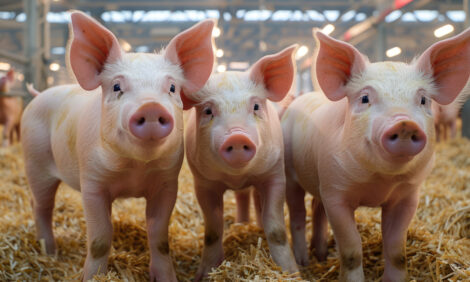



Reduced Nocturnal Temperature for Nursery Pigs
Reducing the nursery house temperature at night by around 10°F can save utility costs without impacting pig performance, according to Lee Johnston and Yuzhi Li of the West Central Research and Outreach Center of the University of Minnesota.What is RNT?
Reduced Nocturnal Temperature (RNT) is simply the reduction in temperature of a room during night-time hours when the pigs are less active and sleeping. During this period, pigs tend to lie close together so they conserve body heat, which could allow reductions in the room temperature.
Where is RNT most applicable?
Probably the most useful application for RNT is in swine nurseries. In general, newly weaned pigs require a relatively high room temperature (over 80°F) to maintain acceptable pig comfort and performance.
Such a high room temperature requires extensive supplemental heating so there may be opportunity for significant savings by reducing the room temperature for a portion of each day. RNT may also be useful in the early stages of growth in wean-to-finish barns and grow-finish barns.
How do we implement RNT?
Many modern, computerised room controllers allow managers to establish different set-point temperatures for a room at different times during the day. A ‘normal’ temperature is set during the daytime hours (07:00 to 19:00) and a cooler set-point temperature is selected for night-time hours (19:00 to 07:00). When the cooler night-time temperature takes over, it is important to allow the room to cool down gradually rather than having the controller try to achieve the cooler temperature rapidly.
Why interest in RNT now?
Researchers found that RNT was a useful management practice for nursery pigs in the 1980s but the practice was not widely adopted.
As fossil fuel prices climb, there is more interest in the practice now. Modern room controllers not available previously allow easy implementation of the altered temperature regimen. Modern, rapidly growing pigs generate more heat than older genetic lines so pigs might be able to adjust to cooler night-time temperatures more easily than older genetics. Finally, the recent interest in reducing the carbon footprint of pork production encourages producers to reduce their consumption of fossil fuels.
What are the potential benefits and risks?
The primary benefit is reduced use of heating fuel that leads to lower cost of production. The primary potential risks are associated with decreased growth rate and efficiency of growth, increased variability in pig performance, and elevated morbidity and mortality associated with chilling especially in light weight pigs.
Does RNT work?
Recently, three universities (University of Minnesota, University of Nebraska, University of Missouri) evaluated RNT in swine nurseries.
In the RNT rooms, night-time set-point temperatures were reduced 10°F from the daytime temperature beginning at 19:00 until 07:00. The temperature reductions began seven days after arrival in the nursery when pigs were about four weeks of age. Temperatures were held constant during the day and night in the control rooms.
Pig performance was not different between control and RNT rooms (Figure 1 and 2). However, there was a 17 per cent reduction in heating fuel use and a nine per cent reduction in use of electricity. These savings translated into a savings of about $1.60 per pig in the nursery (Figure 3).



Is there future research on RNT?
Since pig performance was not affected by a 10°F reduction in temperature, the authors are investigating a larger temperature reduction of 15°F in an experiment funded by the Minnesota Pork Board.
They are also beginning the RNT regimen on the fourth day after pig arrival in the nursery, measuring pig performance, use of heating fuel and pig behaviour. Results of this more aggressive approach will be available in Fall 2011.








